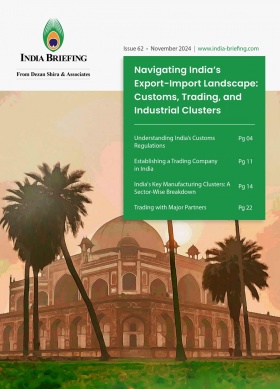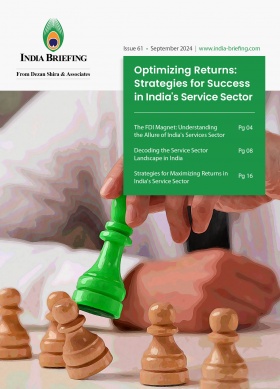Karnataka Global Investor Meet 2025: Over US$115 Billion in Investments Announced, Industrial Policy 2025-30 Unveiled
Held from February 12-14, the Karnataka Global Investor Meet 2025 secured investment proposals worth INR 10.27 trillion (US$118.26 billion). Additionally, the state government launched the Industrial Policy 2025-30, aiming to create two million jobs by 2029, achieve a 12 percent annual manufacturing growth rate, and attract INR 7.5 trillion (US$86.31 billion) in investments.
Karnataka Global Investor Meet 2025: Total investments announced
Karnataka’s three-day 2025 Investor Summit (February 12–14, 2025) focused on strengthening its manufacturing sector and driving employment growth amid evolving economic conditions. The event secured investment commitments totaling INR 10.27 trillion (US$86.31 billion), expected to generate over 600,000 jobs.
Notably, around 75 percent of the proposed investments are outside Bengaluru district, with over 45 percent concentrated in North Karnataka.
As a key contributor to India’s economy, Karnataka leverages its strong industrial and technological base. Bengaluru, the state’s capital and India’s Silicon Valley, remains a global hub for software exports, IT services, and advanced manufacturing.
|
Category |
Amount (INR billion) |
|
Investment commitments announced or recognized by the Karnataka government |
4035.33 |
|
MoUs signed |
6238.45 |
|
Total |
10,273.78 |
Source: Official Press Release, Government of Karnataka
Sector-wise investments
Renewable energy leads with 41 percent of total investments, followed by core manufacturing (15 percent), sunrise sectors (14 percent), infrastructure & industrial/logistics parks (11 percent), general manufacturing (10 percent), and startup capital (9 percent). About 70 percent of these projects are greenfield investments.
|
Industry |
Investment committed |
MoUs signed |
Total |
|
Manufacturing – sunrise sectors |
INR 752.74 billion |
INR 637.19 billion |
INR 1389.93 billion |
|
Manufacturing – general |
INR 524 billion |
INR 526.19 billion |
INR 1050.19 billion |
|
Manufacturing – core |
INR 161.43 billion |
INR 1437 billion |
INR 1598.43 billion |
|
Renewable energy |
INR 813.56 billion |
INR 3444.25 billion |
INR 4257.81 billion |
|
Infrastructure & industrial/ logistics |
INR 884.92 billion |
INR 193.82 billion |
INR 1078.74 billion |
|
Startup capital |
INR 898.68 billion |
|
INR 898.68 billion |
|
Total |
INR 4035.33 billion |
INR 6238.45 billion |
INR 10,273.78 billion |
Source: Government of Karnataka
Country partners and country pavilions – Karnataka Global Investors Meet 2025
|
No. |
Country partner |
Country pavilion |
|
1 |
Australia |
|
|
2 |
United Kingdom |
|
|
3 |
South Korea |
Yes |
|
4 |
France |
|
|
5 |
Italy |
Yes |
|
6 |
Norway |
|
|
7 |
Israel |
|
|
8 |
Netherlands |
Yes |
|
9 |
Japan |
Yes |
|
10 |
Thailand |
Yes |
|
11 |
Taiwan |
Yes |
|
12 |
Poland |
|
|
13 |
Slovenia |
|
|
14 |
Denmark |
Yes |
|
15 |
Malaysia |
Yes |
|
16 |
Switzerland |
|
|
17 |
Bahrain |
|
|
18 |
Singapore |
|
|
19 |
Germany |
Yes |
Source: Government of Karnataka
Swiss companies to explore investment prospects in Karnataka
On February 13, 2025, the Karnataka government signed an MoU with the Swiss-Indian Chamber of Commerce (SICCI) during Invest Karnataka 2025 to strengthen international business collaboration.
Formalized in the presence of the Karnataka State Minister for Large and Medium Industries and representatives from 19 Swiss companies, the agreement aims to bolster trade partnerships and position Karnataka as a top investment destination for global businesses. It also establishes a structured framework for ongoing dialogue between Swiss enterprises and the state government.
Notable investments in Karnataka’s key sectors
With the commencement of the 2025 edition of the investors’ summit, Karnataka has reportedly attracted INR 10 trillion (US$115.07 billion) in investment proposals, with a strong focus on key sectors such as renewable energy, steel, semiconductors, and automobiles.
According to various reports, prominent global and domestic corporations, including Mahindra & Mahindra, JSW Group, Bosch, Toyota Motor, and Foxconn, have committed major investments in the state. Some of the top investment announcements are as follows:
- JSW Group – INR 1.2 trillion (US$13.81 billion) for solar projects, battery storage, a Wind Turbine Generator plant, cement, steel, and affiliate businesses.
- Baldota Steel & Power Ltd. – INR 540 billion (US$6.21 billion) for an integrated steel plant.
- Tata Power Renewable Energy Ltd. – INR 500 billion (US$5.75 billion) for renewable energy power projects and rooftop solutions.
- ReNew Pvt. Ltd. – INR 500 billion (US$5.75 billion) for 4GW of renewable energy projects.
- Serentica Renewables India Pvt. Ltd. – INR 439.75 billion (US$5.06 billion) for renewable energy development.
- Mahindra Susten Pvt Ltd. – INR 360 billion (US$4.14 billion) for renewable energy projects and tourism.
- Hero Future Energies – INR 222 billion (US$2.55 billion) for renewable energy and green hydrogen and its derivatives.
- Suzlon Energy Ltd. – INR 219.5 billion (US$2.52 billion) for wind power projects and wind turbine generator manufacturing.
- Essar Renewables Ltd. – INR 200 billion (US$2.30 billion) for renewable energy projects.
- Avaada Energy Pvt. Ltd. – INR 180 billion (US$2.07 billion) for renewable energy investments.
- Epsilon Group – INR 153.5 billion (US$1.76 billion) for anode and cathode material manufacturing.
- Emmvee Energy Pvt. Ltd. – INR 150 billion (US$1.72 billion) for solar photovoltaic cell and module production.
- Lam Research – INR 100 billion (US$1.15 billion) for semiconductor equipment manufacturing.
- AMPIN Energy Transition Pvt. Ltd. – INR 100 billion (US$1.15 billion) for renewable energy expansion.
- ACME Solar Holdings Ltd. – INR 100 billion (US$1.15 billion) for solar energy development.
- O2 Power Pvt. Ltd. – INR 100 billion (US$1.15 billion) for solar and wind power projects.
- Continuum Green Energy Group – INR 100 billion (US$1.15 billion) for renewable energy expansion.
- Sotefin Bharat – INR 85 billion (US$978 million) for automated robotic parking systems.
- Shree Cement Ltd. – INR 83.5 billion (US$960 million) for an integrated cement plant and clinker grinding unit.
- Hexa Climate Solutions Pvt. Ltd. – INR 80 billion (US$920 million) for climate-friendly industrial projects.
- RSOLEC – INR 50 billion (US$575.58 million) for manufacturing solar ingot wafers.
- Schneider Electric – INR 22.47 billion (US$258.66 million) for manufacturing electrical products and related R&D activities.
- TASL – INR 15.3 billion (US$176.12 million) for helicopter final assembly line (FAL) for Airbus H125, gun manufacturing, and other projects.
- Volvo – INR 14 billion (US$161.16 million) for manufacturing EV trucks.
- Honda – INR 6 billion (US$69.07 million) for manufacturing EV 2-wheelers.
Volvo Group is expanding its manufacturing operations in Karnataka with a new facility in Hosakote, Bengaluru, following a INR 14 billion (US$161.11 million) investment. Announced on February 13, 2025, through an MoU with the Karnataka government, this marks Volvo’s fourth international manufacturing hub. The expansion will create over 2,000 direct jobs, strengthen Karnataka’s position as a global manufacturing hub, and increase the plant’s annual production capacity from 3,000 to 20,000 trucks and buses for domestic and international markets.
Other investments in the state announced across diverse industries include:
- Safran – INR 2.25 billion (US$25.8 million) for avionics manufacturing.
- Bosch – INR 4.5 billion (US$51.7 million) for manufacturing and research facilities.
- Havells – INR 7.10 billion (US$81.7 million) for Tumkur manufacturing expansion and a new Bengaluru R&D center.
- TVS Motor Company – INR 20 billion (US$230 million) for a state-of-the-art R&D facility.
- Ultratech Cement – INR 45 billion (US$517.8 million) for cement production.
- Dalmia Cement – INR 30 billion (US$345.2 million) for cement manufacturing.
- Samvardhana Motherson – INR 37 billion (US$425.7 million) for manufacturing, engineering, and assembly plants.
- ESR Advisers – INR 25 billion (US$287.6 million) for industrial parks and data centers.
- KWIN City Initiatives – Nine universities, including St. John’s University, New York, have shown interest in setting up campuses in KWIN City.
Karnataka’s semiconductor ambitions
With international companies such as Intel, Micron, and TSMC committing to significant semiconductor manufacturing investments, Karnataka is keen to establish itself as a global semiconductor base.
On February 12, 2025, Lam Research, a leading American company, announced an investment of over INR 100 billion (US$1.15 billion) in the state over the coming years. As part of this investment, the company has signed a Memorandum of Understanding (MoU) with the state government to secure a land parcel owned by the Karnataka Industrial Areas Development Board (KIADB) for the development of semiconductor manufacturing infrastructure.
Lam Research is largely known for developing advanced semiconductor manufacturing tools, which are crucial for wafer processing and semiconductor device wiring.
Karnataka’s Industrial Policy 2025-30 unveiled
On February 11, 2025, the Karnataka state government launched its Industrial Policy 2025-30. The policy outlines ambitious goals, including creating two million jobs by 2029, achieving a 12 percent annual growth rate in the manufacturing sector, and drawing INR 7.5 trillion (US$83.6 billion) in investments.
The policy’s core focus area is to build up high-growth sectors such as electronics system design and manufacturing (ESDM), advanced manufacturing, etc.
Key objectives of Karnataka’s Industrial Policy 2025-30
- Manufacturing expansion: Increase in the annual manufacturing sector growth to 12 percent, attracting INR 7.5 trillion (US$83.6 billion) in investments.
- Sustainability leadership: Position the state as a pioneer in green and sustainable industrial practices.
- Advancement in high-growth sectors: Strengthen its position in ESDM, advanced manufacturing, aerospace and defense, and future mobility.
- Regional industrial development: Promote balanced economic expansion in underdeveloped regions.
- Investor-friendly reforms: Streamline approval processes through digitalization and the enhanced Single Window System (SWS).
Among the highlights of Karnataka’s Industrial Policy 2025-30 is the introduction of flexible incentive options. Investors can choose between Production-Linked Incentives (PLI) or capital subsidies, allowing both high-capital and high-turnover industries to benefit from customized support. This approach ensures that businesses, regardless of their scale, receive financial backing suited to their investment model.
The policy also emphasizes green manufacturing. Karnataka-based companies implementing sustainability initiatives, such as Zero Liquid Discharge (ZLD), air pollution control, energy efficiency, and thermal process electrification, will be eligible for one-time capital subsidies. Furthermore, additional incentives have been included for businesses that secure Greenco certifications, reinforcing the state’s objective to foster environmentally responsible industrialization.
Acknowledging the rising importance of logistics and warehousing, the state government has granted industry status to this sector, facilitating enhanced investment and policy support. The policy further enhances warehousing infrastructure by offering up to 20 percent capital subsidy on fixed capital investment in warehousing projects. Additional benefits include stamp duty reimbursements and electricity duty exemptions for five years, making the region a more attractive destination for logistics and storage investments.
To address workforce skill shortages, the state will launch upskilling initiatives, including:
- Industry-integrated workshops and skill gap assessments.
- Vocational and technical training programs aligned with industry needs.
- Incorporation of specialized courses in Industrial Training Institutes (ITIs) to build a skilled workforce for the sector.
- These initiatives aim to bridge skill gaps, enhance workforce competencies, and strengthen Karnataka’s position as a logistics and warehousing hub.
To improve worker accommodation and living conditions, industrial dormitories will receive up to INR 10 million in capital subsidies or PLI for every 1,000-person accommodation.
To foster R&D and manufacturing synergy, companies that establish R&D centers or Global Capability Centers (GCCs) alongside their manufacturing units will receive an extra 10 percent incentive.
Strategic policies to drive industrial development in Karnataka
The Karnataka state government plans to establish 12 new investment zones across 30,000 acres, complementing the 200+ existing industrial areas. As per its State Minister for Large and Medium Industries, M.B. Patil, these investment zones will feature world-class infrastructure, with INR 38 billion (US$437.2 million) allocated for clean water supply to industrial zones.
In a move to further industrial expansion, Karnataka will also see development of sector-specific industrial parks, including the Advanced Pharma Park in Kolar, a Solar Cell Park and Food Park in Vijayapura, a Drone Park in Chitradurga, and EV clusters in Chikkaballapur and Dharwad.
Additionally, the 200-acre Startup Park in Hubballi, poised to support over 400 startups, and the 1,200-acre industrial park in Tidagundi, Vijayapura, all support Karnataka’s commitment to becoming a global industrial hub.
At present, the KIADB has developed 85,000 acres of industrial land, which accommodates 25,000 industries.
Digital transformation and single window system overhaul
The state has also restructured its Single Window System (SWS) by launching Udyog Mitra Assistant (UMA), an AI-driven, multilingual chatbot that offers real-time guidance on policies, approvals, and incentives. The upgraded SWS is mobile-optimized and integrates over 150 business services across 30+ state departments, streamlining approval processes at both district and state levels.
As announced on February 11, 2025, the revamped SWS aims to provide a seamless and efficient investment experience, eliminating the need for businesses to navigate multiple government agencies. The system enables online applications, amendments, and renewals of approvals, no objection certificates (NOCs), and clearances, significantly improving processing efficiency and reducing turnaround times. Investors can now obtain in-principle approvals at both district and state levels through a Common Application Form (CAF), ensuring a more transparent and structured approval process.
To better align with national policies, the SWS is now linked to the National Single Window System and other central government frameworks.
A key feature of Karnataka’s new single window system is that it provides real-time status updates on approval applications, along with live dashboards and SLA tracking that help state government agencies monitor approvals, address process inefficiencies, and ensure timely service delivery. The chatbot reportedly also includes a grievance resolution system also allows users to submit and track their concerns online.
The SWS system will introduce Affidavit-Based Clearance (ABC) for the manufacturing sector, allowing businesses to commence construction and preparatory activities based on an affidavit submission to Karnataka Udyog Mitra, rather than waiting for multiple departmental approvals. This initiative is designed to accelerate project timelines and expedite operations.
Furthermore, KIADB has launched a Digital Management System for tracking land availability, allotment, and building plan approvals in real-time. With GIS-based tools, investors seeking private or revenue land can verify zoning and siting regulations before acquiring property for their projects. The integration of digital tracking ensures that Karnataka remains at the forefront of industrial innovation and economic expansion.
Key takeaways
-
Karnataka received investment proposals worth INR 10.27 trillion during the three-day Global Investor Meet 2025 [February 12-14], reaffirming its position as a leading destination for industrial and technological investments.
-
The state’s ambitious investment targets focus on renewable energy, semiconductors, steel, and automobiles, attracting top global companies such as Mahindra & Mahindra, JSW Group, Bosch, Toyota Motor, and Foxconn.
-
Karnataka is emerging as a global semiconductor hub, with companies like Intel, Micron, and TSMC making substantial commitments, including INR 100 billion (US$1.15 billion) by Lam Research for semiconductor equipment manufacturing.
-
The newly launched Industrial Policy 2025-30 aims to create 2 million jobs by 2029, achieve a 12 percent annual manufacturing sector growth, and attract INR 7.5 trillion (US$83.6 billion) in investments. The policy also includes flexible subsidies, allowing businesses to choose between Production-Linked Incentives (PLI) or capital subsidies, benefiting both high-capital and high-turnover industries.
-
The government has granted industry status to the logistics and warehousing sector, offering 20 percent capital subsidies for infrastructure development, stamp duty reimbursements, and electricity duty exemptions for five years.
-
Karnataka is developing 12 new investment zones across 30,000 acres, alongside sector-specific industrial parks, including an advanced pharma park, drone park, and EV clusters.
-
The state is addressing workforce shortages by launching technical training programs, vocational workshops, and specialized ITI courses, ensuring a skilled labor force for its expanding industries.
-
The Single Window System (SWS) has been upgraded with an AI-driven application for seamless real-time approvals, tracking, and grievance resolution, reducing bureaucratic delays.
-
Affidavit-Based Clearance (ABC) for Faster Implementation: The ABC initiative allows businesses to commence construction and preparatory work based on affidavit submissions, expediting investment execution timelines.
-
Advancing Smart Land Management: The KIADB Digital Management System enables real-time tracking of land availability, allotments, and zoning compliance through GIS-based tools, ensuring a streamlined investment process.
(US$1 = INR 86.87)
(This article was originally published on February 12, 2025. It was last updated February 19, 2025.)
About Us
India Briefing is one of five regional publications under the Asia Briefing brand. It is supported by Dezan Shira & Associates, a pan-Asia, multi-disciplinary professional services firm that assists foreign investors throughout Asia, including through offices in Delhi, Mumbai, and Bengaluru in India. Readers may write to india@dezshira.com for support on doing business in India. For a complimentary subscription to India Briefing’s content products, please click here.
Dezan Shira & Associates also maintains offices or has alliance partners assisting foreign investors in China, Hong Kong SAR, Dubai (UAE), Indonesia, Singapore, Vietnam, Philippines, Malaysia, Thailand, Bangladesh, Italy, Germany, the United States, and Australia.
- Previous Article Competition Commission of India Introduces Draft Regulations on Predatory Pricing
- Next Article BRSR Reporting in India: Key Changes to ESG Disclosures Introduced by SEBI








